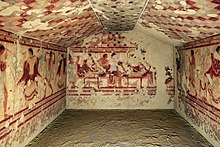Tomba del Triclinio
The Tomb of the Triclinium (German: "grave with the triclinium ") is a full maltes Etruscan grave in Tarquinia in the Italian province of Viterbo . It is part of the Monterozzi Necropolis , which has been a UNESCO World Heritage Site since 2004 .
The paintings
The grave dates from between 480 and 450 BC. The frescoes are no longer in the tomb, but are exhibited in the National Museum of Tarquinia. The grave itself was found in 1830. The painter of the original showed an extraordinary taste in the delicacy of decoration and such a skill in drawing that he has been mistaken for a Greek painter, or at least a painter trained in Greece.
The distribution scheme of the tomb paintings was such that a banquet scene took place on the back wall and games and dances on the sides. These dance scenes here are the most beautiful in Tarquinia with their grace, variety of movements and detailed gestures - nothing about them is exaggerated or violent. There is an atmosphere of calm and peace. Birds fly between the branches or peck at berries, a cat climbs a tree, a hare lies on the ground.
The paintings are two-colored - brown and blue. The bodies and the robes that end in ancient swallowtail folds have soft, flowing lines; they show few, strong foreshortenings and a certain tendency towards monumentality. The knowledge of late Archaic vase painting is reflected in the drawings of the figures.
The paintings in this tomb are an extremely valuable document of the influence of Greek painting in Etruria . The Etruscan artists changed the Greek models quite freely according to their own taste and introduced new themes and new expressive values. The local component is not only noticeable in the realism with which the details of the room and the clothing are reproduced, but is also evident in the rich colors and the deliberately soft lines.
The paintings in the tomb show some similarities with the Tomba del Letto Funebre and the Tomba Claudio Bettini . It is believed that these graves were made by the same workshop.
The drawings by Carlo Ruspi
Carlo Ruspi made drawings of the most famous tombs of Tarquinia , which became very famous and contributed to the fame of the tombs of Tarquinia. Ruspi made the colored break in this grave around 1830 immediately after the grave was discovered. Ruspi carried out these tracing drawings practically freehand by tracing the outlines that shone through the tracing paper with a fine brush so as not to damage the precious original. During the breaks he wrote down numerous details about shapes and colors. Eventually these drawings were transferred to sturdy paper. This work was supported by the former Bavarian King Ludwig I supported.
Since these drawings were not subject to the protection of historical monuments like the originals, Ruspi was able to produce a color intensity that he imagined at the time of creation. The original drawings known today are paler. However, the colors of the originals in Tarquinia are no longer original. The colors 2000 years ago are more like what Carlo Ruspi painted around 1830.
Individual evidence
- ^ Stephan Steingräber : Abundance of Life, Etruscan Wall Painting . Los Angeles 2006, ISBN 978-0-89236-865-5 , p. 134.
literature
- Robert Hess, Elfriede Paschinger: Etruscan Italy. Discovery trips to the art sites and necropolis of the Etruscans. Fifth edition. DuMont, Cologne 1985, ISBN 3-7701-0637-7 .
- Maja Sprenger , Gilda Bartoloni: The Etruscans. Art and history. Recordings by Max and Albert Hirmer. Hirmer, Munich 1977, ISBN 3-7774-2890-6 .
- Ezio Renda: Tarquinia. German edition. Bonechi Edizioni "Il Turismo", Florence 1984.
Web links
Coordinates: 42 ° 14 ′ 55.5 " N , 11 ° 46 ′ 17.8" E




